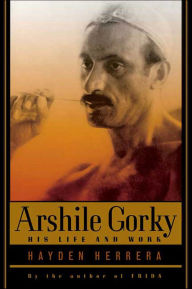Read an Excerpt
ARSHILE GORKY
PART I
1
Charahan Surp Nishan
On a summer night in 1903 near the shore of Lake Van in Turkish Armenia, the Der Marderosian family gathered in their ancient monastery church, Charahan Surp Nishan. Arshile Gorky's grandmother, the widow Hamaspiur, had brought the family together to hold a vigil for her youngest son, sixteen-year-old Nishan, who had vanished several days before. She suspected that he had been abducted by Kurds, for he had fallen in love with a Kurdish girl whose brother took offense. Widow Hamaspiur knew that Armenians who erred in any way were fair game for Turkish or Kurdish brutality. Only five years earlier, her husband, Sarkis Der Marderosian, the last of a long line of Armenian apostolic priests, had been nailed to the door of the church where he served in Van City.
Gorky's mother, Shushan, may have joined her mother and her five siblings at this vigil. Perhaps Shushan brought her children to the vigil too--her daughters, Akabi and Satenik, and her tiny son, Vosdanig, who a year or so later would be renamed Manouk and a quarter of a century after that, in America, would change his name to Arshile Gorky.
As the Der Marderosian family sat on the carpet-covered floor beneath the smoke-blackened dome of the tiny stone church, the faint flicker of incense candles lit their solemn faces. The summer heat, the darkness outside, and the binding mood of apprehension made the square room seem close. Finally, over the murmur of their prayers came the sound of a thud against the heavy wooden church doors. Hamaspiur Der Marderosian rose to open them. On the threshold lay her favoriteson's body. It was covered with dagger wounds and his clothes were soaked in blood.
Centuries of living as a subject minority in Ottoman Turkey had given the Armenian people, once known for their rugged independence, a fatalistic passivity, but Hamaspiur did not follow her countrymen's habit of accepting fate. Instead she clenched her fists and wept. Months went by and each day the force with which she rejected God's will grew. She paced back and forth inside the church dedicated to the fifth-century saint Yeghisheh, whose power to cure madness gave Charahan Surp Nishan its name: Holy Sign of the Demon Seizer. In her fury, Hamaspiur resembled the insane people who used to be chained to a pillar near Saint Yeghisheh's relics until their screams were spent and the devils within them were expelled. No such miracle would cure her grief. Her endless pacing took her out into the graveyard, past her husband's gravestone, where she could look over the ever-changing surface of Lake Van, a lake so vast it has been called an inland sea. Hamaspiur Der Marderosian beat her hands and forehead against the church doors and cried, "Why, oh God, did you take him?" There was no answer except, her family said, in recurrent nightmares, and that answer gave no solace: "Beat not on my doors," said the voice of God. Having been warned in a dream that his mother's blasphemy would bring a curse on her family, her eldest son, Moses, tried to silence her. But Hamaspiur's grief was beyond even her son's remonstrations.
To revenge herself against God, Hamaspiur set Charahan Surp Nishan on fire. Only the wooden parts of the structure, the altar, and other accoutrements burned. Most of the church was built of stone and remained intact. The local villagers were horrified at what Hamaspiur had done. With this act of sacrilege, the Der Marderosians' official ties to the church were severed. Hamaspiur left the walled monastery complex to spend the last six years of her life in a monastery in the mountain village of Ermerur. Charahan Surp Nishan and its lands were rented to a priest and fell into decay.
Arshile Gorky would look back with admiration at his grandmother's rebellious spirit. As a grown man, he had a passion for fire. "I think our lives flow like a molten lava," he said. The hot light of embers and flames glows in many of his paintings and drawings. For Gorky no celebration was complete without a bonfire, and every fire he built had to be a conflagration. But, according to family legend, Hamaspiur's fire had broughta curse on her descendants. Though he left religion as a young man, Gorky was superstitious, and he felt that curse. He told friends that his mother used to call him "the black one, the unlucky one who will come to a no-good end." The fatalistic attitude with which he bore life's sufferings astonished those close to him.
This fatalism showed up during the Great Depression when poverty, neglect, and the struggles associated with being an artist nearly overwhelmed him: Gorky would shrug his shoulders and say that to suffer for art was his destiny. Discussing thought versus feeling in art with friends at the Waldorf Cafeteria in New York in the 1930s, Gorky startled them by suddenly interjecting: "The story of Christ is misunderstood. In my ancient country we saw the story differently. The figure of Christ was that of a man of fate, not a man of tragedy who gives his life to save us. In my country the son is a man of fate. It is the fate of the son to kill his father, but Christ's father was God and Christ couldn't kill God." His companions assumed that Gorky was talking about his compulsion to be loyal to father Picasso. Gorky could not kill off his artistic progenitor; he had to follow as a worthy disciple. "I am not a man burdened by art but necessarily doing what I must do," Gorky said. "I am, therefore, not a tragic hero like Christ but I am a man of fate."
Copyright © 2003 by Hayden Herrera













